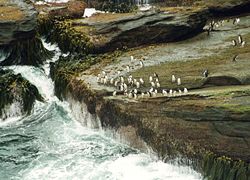| New Island | |
 | |
Location  | |
| State | UK |
|---|---|
| Region | Falkland Islands |
| Surface | 22.7 km² |
| Tourism site | |
New Island (Isla de Goicoechea in Spanish) is one of the islands belonging to Falkland Islands.
To know

Geographical notes
New Island is located in the western part of the Falkland Islands, approximately 240 km from Port Stanley.
Background
From 1977 to 2006, the island was divided into two properties: New Island South, directed and managed as a nature reserve by the New Island South Conservation Trust; and New Island North, run by Tony Chater. However in July 2006 The New Island South Conservation Trust also acquired the northern part of the island, and now manages the entire island as a reserve. Ian Strange, a wildlife conservationist, author and photographer manages the island on behalf of the Trust.
Territories and tourist destinations
How to get
By plane
For visitors wishing to visit New Island for a night or more, access to the island from Port Stanley, via small 8-seat Islander aircraft. Housing availability is very limited due to the fact that much of it is already being used by field workers and scientists working at the New Island South Reserve.
To find out if an overnight stay you can contact Ian Strange through the New Island South Conservation Trust site.
Most visitors to New Island arrive by cruise ship. In order to reduce disturbance and impact to the island's fauna and natural environment, New Island only allows relatively small cruise ships (max. 150-200 passengers) to visit the island. Visiting cruise ships usually stop in the southern half of the island for about three hours, allowing visitors to take a walk that allows them to observe colonies of Rockhopper penguins, black-browed albatrosses, and king cormorants.
How to get around
What see
The island is relatively small, but boasts a large colony of Rockhopper penguins and black-browed albatrosses on the cliffs opposite the settlement on the western side of the island. The colony can be reached with an easy path about one kilometer from the village. The eastern half of the island slopes more gently towards the sea and is home to Magellanic penguins, gentoo (or gentoo) penguins, oystercatchers and numerous other bird species. Southern dolphins will frequently accompany the rafts to the shore and may even swim in shallow water (up to the knee) to study visitors more closely. Falkland seals and southern sea lions can be glimpsed around the island. Whale sightings are frequent during animal migration in the summer months.
The island has a great history with the remains of an old 1908 whaling station on New South Island, the still standing wreck of an old minesweeper beached near the settlement, and the recently restored stone building. "The Barnard Building"; part of which was built and used as a refuge by Captain Charles Barnard, a captain of the North American Whaling which was abandoned on New Island for 2 years in 1812.
The island's landscape is second to none. The sheer cliffs on the west coast of the island are absolutely spectacular and the clean white sand beaches of the east coast are bathed in crystal clear turquoise waters teeming with marine life.
After dark, a true wildlife spectacle can be seen a few meters from the houses of the small settlement with thousands of thin-beaked prions returning to their burrows under the cover of darkness. These birds transform the sky into a mass of noisy birds, each looking for a partner in the area. Equally spectacular are the night skies; the clarity of the atmosphere, and the total absence of light pollution make New Island one of the best places in the world to see the stars and planets with unparalleled visibility.
Events and parties
What to do
The whole island can be explored on foot. Little physical effort is needed to visit some spectacular places. The cliffs overlooking the western side of the island plunge 600 meters into the sea, where seals, dolphins, petrels, albatrosses, and even whales can be regularly spotted. On the eastern side of the island the white sandy beaches offer total tranquility and relaxation. Since wildlife incredibly dominates the island it is a veritable paradise for keen wildlife photographers.
Shopping
How to have fun
Where to eat
There is no food available on the island; all supplies must be brought with you in advance. Drinking water can be obtained (with permission) from the settlement.
Where stay
New Island South has self contained accommodation which may be available at certain times during the summer season (roughly October to March). There are 2 independent buildings with basic services. Please contact the Trust's Warden to ensure availability during the period of interest.
Although the island is primarily a destination for lovers of outdoor activities, camping is generally not allowed on New Island South due to the risks associated with the high unpredictability of the weather and the high risk of fires on the island. .
Safety
How to keep in touch
Around
Other projects
 Commons contains images or other files on New Island
Commons contains images or other files on New Island
